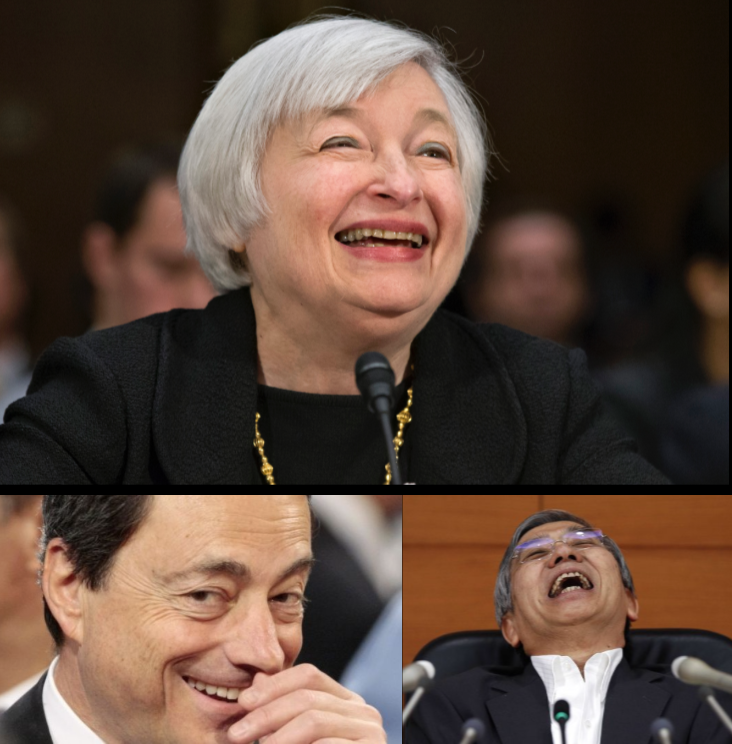“The power to do good is also the power to do harm.” – Milton Friedman
Will they?
Won’t they?
Hearsay.
Unelected, unaccountable, unaudited bureaucrats playing with other people’s money can do anything they like.
Currently, the Fed Fund Futures are pricing in a 30% probability of a rate increase this week. There has been plenty of noise over the past year with respect to a rate hike, most of it perpetuated by a storytelling Fed. However, there are historical precedents and data that provide context for the upcoming rate decision:
- The Federal Reserve has never raised interest rates into an economic slowdown.
- The Federal Reserve has not raised the fed funds target rate since June 2006 (110 months) and has maintained 0-0.25% crisis levels since Dec 2008 (81 months).
- There have been in excess of 50 central bank rate cuts globally thus far in 2015; and
- The Federal Reserve did not raise rates in 2013 when the US economy accelerated from 0% to 4% growth in three quarters (as the UST 10-yr yield went from 2% to 3%).
The economic landscape has shifted from the 2013 accelerating-growth scenario. What we are experiencing now is decelerating growth, not just in the U.S., but globally.
Try making up for a past mistake and make another? That's playing from behind, if you will, and it's not out of the question if you know the Fed’s history:
- Not a single post-war recession has been predicted by the Fed a year in advance, according to former U.S. Treasury Secretary Lawrence Summers; and
- Neither of the last three recessions were recognized until they were already under way.
Incompetent or ulterior motives for policy?
Regardless, here we are with expectations ramped up for a rate hike, as the rest of the world is easing.
What’s notable for investors is that since the 2008 crash, we have not been able to achieve new market highs without central bank stimulus. Full stop.
But it’s only a quarter point…
According to a study released by McKinsey Global Institute in February of this year, global debt has increased by $57 trillion USD since 2008. With such an enormous amount liquidity in the system (M1 money supply near lifetime highs) financial markets are increasingly becoming nothing more than a currency game; and the currency game is a relative one. I print, you print, they print, but who’s printing more and where is capital flowing in and out of? Within this context, a quarter-point rate hike would be much more than simply symbolic.
As we have seen since late 2012, the rise in the U.S. dollar has had major implications on global markets, whether it be currencies, commodities or interest rates. A rate hike would equate to further USD strength and will accelerate the deflationary spiral we have witnessed over the past few years. Raising rates into a slowdown could also place the U.S. firmly on a path to recession in 2016.
Conversely, no rate increase does not meet the expectations set by the Fed and will re-inflate commodities in the immediate term. Arguably, it pulls forward the possibility of QE4 as well.
So it seems the Fed finds itself in a self-imposed conundrum here: make a policy error and raise into a slowdown, don’t raise and openly recognize growth is slowing. Which brings me back to my previous point: since 2008, no new market highs have been achieved without central bank stimulus.
As always, government remains the No. 1 risk to financial markets, and I will change my views as the facts change.
“The Federal Reserve is not currently forecasting a recession.” – Ben Bernanke (January 2008)
Alim Abdulla is an Investment Advisor at Leede Financial and is a co-founder of the Trading Analytics Group (TAG). He has been with Leede for nine years and began his career in the Financial Industry a year prior at Canaccord Capital. Alim considers himself to be an Active Risk Manager focused on long/short equity portfolios.
Disclaimer: The comments and opinions expressed herein reflect the personal views of Alim Abdulla. They may differ from the opinions of Leede Financial Markets Inc. and should not be considered representative of the research beliefs, opinions or recommendations of Leede Financial Markets Inc. The information included in this document, including any opinion, is based on various sources believed to be reliable, but its accuracy and completeness is not guaranteed. Member CIPF.























